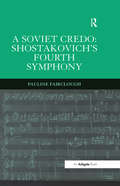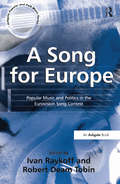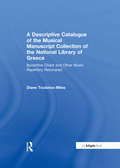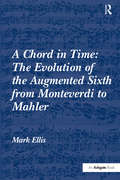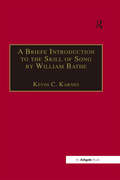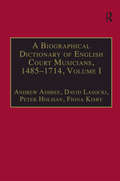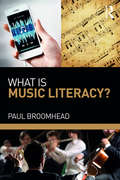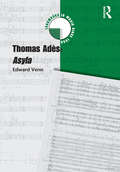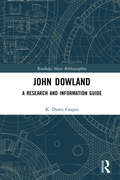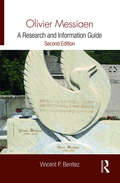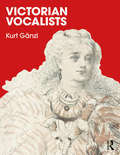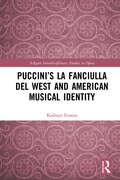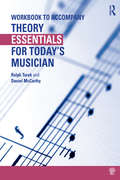- Table View
- List View
A Soviet Credo: Shostakovich's Fourth Symphony
by Pauline FaircloughComposed in 1935-36 and intended to be his artistic 'credo', Shostakovich's Fourth Symphony was not performed publicly until 1961. Here, Dr Pauline Fairclough tackles head-on one of the most significant and least understood of Shostakovich's major works. She argues that the Fourth Symphony was radically different from its Soviet contemporaries in terms of its structure, dramaturgy, tone and even language, and therefore challenged the norms of Soviet symphonism at a crucial stage of its development. With the backing of prominent musicologists such as Ivan Sollertinsky, the composer could realistically have expected the premiere to have taken place, and may even have intended the symphony to be a model for a new kind of 'democratic' Soviet symphonism. Fairclough meticulously examines the score to inform a discussion of tonal and thematic processes, allusion, paraphrase and reference to musical types, or intonations. Such analysis is set deeply in the context of Soviet musical culture during the period 1932-36, involving Shostakovich's contemporaries Shebalin, Myaskovsky, Kabalevsky and Popov. A new method of analysis is also advanced here, where a range of Soviet and Western analytical methods are informed by the theoretical work of Shostakovich's contemporaries Viktor Shklovsky, Boris Tomashevsky, Mikhail Bakhtin and Ivan Sollertinsky, together with Theodor Adorno's late study of Mahler. In this way, the book will significantly increase an understanding of the symphony and its context.
A Soviet Credo: Shostakovich's Fourth Symphony
by Pauline FaircloughComposed in 1935-36 and intended to be his artistic 'credo', Shostakovich's Fourth Symphony was not performed publicly until 1961. Here, Dr Pauline Fairclough tackles head-on one of the most significant and least understood of Shostakovich's major works. She argues that the Fourth Symphony was radically different from its Soviet contemporaries in terms of its structure, dramaturgy, tone and even language, and therefore challenged the norms of Soviet symphonism at a crucial stage of its development. With the backing of prominent musicologists such as Ivan Sollertinsky, the composer could realistically have expected the premiere to have taken place, and may even have intended the symphony to be a model for a new kind of 'democratic' Soviet symphonism. Fairclough meticulously examines the score to inform a discussion of tonal and thematic processes, allusion, paraphrase and reference to musical types, or intonations. Such analysis is set deeply in the context of Soviet musical culture during the period 1932-36, involving Shostakovich's contemporaries Shebalin, Myaskovsky, Kabalevsky and Popov. A new method of analysis is also advanced here, where a range of Soviet and Western analytical methods are informed by the theoretical work of Shostakovich's contemporaries Viktor Shklovsky, Boris Tomashevsky, Mikhail Bakhtin and Ivan Sollertinsky, together with Theodor Adorno's late study of Mahler. In this way, the book will significantly increase an understanding of the symphony and its context.
A Song for Europe: Popular Music and Politics in the Eurovision Song Contest
by IVAN RAYKOFF and ROBERT DEAM TOBINThe world's largest and longest-running song competition, the Eurovision Song Contest is a significant and extremely popular media event throughout the continent and abroad. The Contest is broadcast live in over 30 countries with over 100 million viewers annually. Established in 1956 as a televised spectacle to unify postwar Western Europe through music, the Contest features singers who represent a participating nation with a new popular song. Viewers vote by phone for their favourite performance, though they cannot vote for their own country's entry. This process alone reveals much about national identities and identifications, as voting patterns expose deep-seated alliances and animosities among participating countries. Here, an international group of scholars from a variety of disciplines, including musicology, communications, history, sociology, English and German studies, explore how the contest sheds light on issues of European politics, national and European identity, race, gender and sexuality, and the aesthetics of camp. For some countries, participation in Eurovision has been simultaneously an assertion of modernity and a claim to membership in Europe and the West. Eurovision is sometimes regarded as a low-brow camp spectacle of little aesthetic or intellectual value. The essays in this collection often contradict this assumption, demonstrating that the contest has actually been a significant force and forecaster for social, cultural and political transformations in postwar Europe.
A Song for Europe: Popular Music and Politics in the Eurovision Song Contest
by RobertDeam TobinThe world's largest and longest-running song competition, the Eurovision Song Contest is a significant and extremely popular media event throughout the continent and abroad. The Contest is broadcast live in over 30 countries with over 100 million viewers annually. Established in 1956 as a televised spectacle to unify postwar Western Europe through music, the Contest features singers who represent a participating nation with a new popular song. Viewers vote by phone for their favourite performance, though they cannot vote for their own country's entry. This process alone reveals much about national identities and identifications, as voting patterns expose deep-seated alliances and animosities among participating countries. Here, an international group of scholars from a variety of disciplines, including musicology, communications, history, sociology, English and German studies, explore how the contest sheds light on issues of European politics, national and European identity, race, gender and sexuality, and the aesthetics of camp. For some countries, participation in Eurovision has been simultaneously an assertion of modernity and a claim to membership in Europe and the West. Eurovision is sometimes regarded as a low-brow camp spectacle of little aesthetic or intellectual value. The essays in this collection often contradict this assumption, demonstrating that the contest has actually been a significant force and forecaster for social, cultural and political transformations in postwar Europe.
A Descriptive Catalogue of the Musical Manuscript Collection of the National Library of Greece: Byzantine Chant and Other Music Repertory Recovered
by DianeH. Touliatos-MilesThe National Library of Greece (Ethnike Bibliothike tes Ellados) is one of the richest depositories of Byzantine musical manuscripts and is surpassed by its holdings in Greece only by the multitude of manuscripts found in the monasteries of Mount Athos. In spite of being such a rich archive, the National Library has never published a catalogue of its musical manuscripts - not all of which are Byzantine or Greek. It is the purpose of this catalogue to recover or, in some instances, to present for the first time the repertory of the musical sources of the library. This project has been twelve years in the making for Professor Diane Touliatos, involving the discovery and detailed cataloguing of all 241 Western, Ancient Greek, and Byzantine music manuscripts. Not all of these are from Athens or modern Greece, but also encompass Turkey, the Balkans, Italy, Cyprus, and parts of Western Europe. This variety underlines the importance of the catalogue for identifying composers, music and performance practice of different locales. The catalogue includes a detailed listing of the contents as written in the original language as well as the titles of compositions (and/or incipits) with composers, modal signatures, other attributions and information on performance practice. Each manuscript entry includes a commentary in English indicating important highlights and its significance. There is a substantive English checklist that summarizes the contents of each manuscript for non-Greek readers. A bibliography follows containing pertinent citations where the manuscript has been used in references. There is also a glossary that defines terms for the non-specialist. Examples of some of the manuscripts will be photographically displayed. The catalogue will enlighten musicologists and Byzantinists of the rich and varied holdings of some of the most important musical manuscripts in existence, and stimulate more interest and investigation of these sources. As such, it will fill a major ga
A Descriptive Catalogue of the Musical Manuscript Collection of the National Library of Greece: Byzantine Chant and Other Music Repertory Recovered
by DianeH. Touliatos-MilesThe National Library of Greece (Ethnike Bibliothike tes Ellados) is one of the richest depositories of Byzantine musical manuscripts and is surpassed by its holdings in Greece only by the multitude of manuscripts found in the monasteries of Mount Athos. In spite of being such a rich archive, the National Library has never published a catalogue of its musical manuscripts - not all of which are Byzantine or Greek. It is the purpose of this catalogue to recover or, in some instances, to present for the first time the repertory of the musical sources of the library. This project has been twelve years in the making for Professor Diane Touliatos, involving the discovery and detailed cataloguing of all 241 Western, Ancient Greek, and Byzantine music manuscripts. Not all of these are from Athens or modern Greece, but also encompass Turkey, the Balkans, Italy, Cyprus, and parts of Western Europe. This variety underlines the importance of the catalogue for identifying composers, music and performance practice of different locales. The catalogue includes a detailed listing of the contents as written in the original language as well as the titles of compositions (and/or incipits) with composers, modal signatures, other attributions and information on performance practice. Each manuscript entry includes a commentary in English indicating important highlights and its significance. There is a substantive English checklist that summarizes the contents of each manuscript for non-Greek readers. A bibliography follows containing pertinent citations where the manuscript has been used in references. There is also a glossary that defines terms for the non-specialist. Examples of some of the manuscripts will be photographically displayed. The catalogue will enlighten musicologists and Byzantinists of the rich and varied holdings of some of the most important musical manuscripts in existence, and stimulate more interest and investigation of these sources. As such, it will fill a major ga
A Chord in Time: The Evolution of the Augmented Sixth from Monteverdi to Mahler
by Mark EllisFor centuries, the augmented sixth sonority has fascinated composers and intrigued music analysts. Here, Dr Mark Ellis presents a series of musical examples illustrating the 'evolution' of the augmented sixth and the changing contexts in which it can be found. Surprisingly, the sonority emerged from one of the last remnants of modal counterpoint to survive into the tonal era: the Phrygian Cadence. In the Baroque period, the 'terrible dissonance' was nearly always associated with negative textual imagery. Charpentier described the augmented sixth as 'poignantly expressive'. J. S. Bach considered an occurrence of the chord in one of his forebear's motets 'remarkably bold'. During Bach's composing lifetime, the augmented sixth evolved from a relatively rare chromaticism to an almost commonplace element within the tonal spectrum; the chord reflects particular chronological and stylistic strata in his music. Theorists began cautiously to accept the chord, but its inversional possibilities proved particularly contentious, as commentaries by writers as diverse as Muffat, Marpurg and Rousseau reveal. During the eighteenth century, the augmented sixth became increasingly significant in instrumental repertoires - it was perhaps Vivaldi who first liberated the chord from its negative textual associations. By the later eighteenth century, the chord began to function almost as a 'signpost' to indicate important structural boundaries within sonata form. The chord did not, however, entirely lose its darker undertone: it signifies, for example, the theme of revenge in Mozart's Don Giovanni. Romantic composers uncovered far-reaching tonal ambiguities inherent in the augmented sixth. Chopin's Nocturnes often seem beguilingly simple, but the surface tranquillity masks the composer's strikingly original harmonic experiments. Wagner's much-analyzed 'Tristan Chord' resolves (according to some theorists) on an augmented sixth. In Tristan und Isolde, the chord's mercurial
A Chord in Time: The Evolution of the Augmented Sixth from Monteverdi to Mahler
by Mark EllisFor centuries, the augmented sixth sonority has fascinated composers and intrigued music analysts. Here, Dr Mark Ellis presents a series of musical examples illustrating the 'evolution' of the augmented sixth and the changing contexts in which it can be found. Surprisingly, the sonority emerged from one of the last remnants of modal counterpoint to survive into the tonal era: the Phrygian Cadence. In the Baroque period, the 'terrible dissonance' was nearly always associated with negative textual imagery. Charpentier described the augmented sixth as 'poignantly expressive'. J. S. Bach considered an occurrence of the chord in one of his forebear's motets 'remarkably bold'. During Bach's composing lifetime, the augmented sixth evolved from a relatively rare chromaticism to an almost commonplace element within the tonal spectrum; the chord reflects particular chronological and stylistic strata in his music. Theorists began cautiously to accept the chord, but its inversional possibilities proved particularly contentious, as commentaries by writers as diverse as Muffat, Marpurg and Rousseau reveal. During the eighteenth century, the augmented sixth became increasingly significant in instrumental repertoires - it was perhaps Vivaldi who first liberated the chord from its negative textual associations. By the later eighteenth century, the chord began to function almost as a 'signpost' to indicate important structural boundaries within sonata form. The chord did not, however, entirely lose its darker undertone: it signifies, for example, the theme of revenge in Mozart's Don Giovanni. Romantic composers uncovered far-reaching tonal ambiguities inherent in the augmented sixth. Chopin's Nocturnes often seem beguilingly simple, but the surface tranquillity masks the composer's strikingly original harmonic experiments. Wagner's much-analyzed 'Tristan Chord' resolves (according to some theorists) on an augmented sixth. In Tristan und Isolde, the chord's mercurial
A Briefe Introduction to the Skill of Song by William Bathe
by William Bathe and Kevin C. KarnesAlthough unjustly neglected by modern writers, William Bathe‘s contributions to music pedagogy in late sixteenth-century England were profound. Bathe‘s A Briefe Introduction to the Skill of Song (1596) not only includes the first explication of a four-syllable, non-hexachordal solmization method published by an English writer (a system similar to that which would become the standard in England during the seventeenth century) but also outlines a combinatorial method for composing canons that is remarkably forward-looking in both conception and design. In addition to providing the first modern edition of Bathe‘s treatise, the volume examines the complicated compilation and publication histories of the book, the historical and theoretical foundations of Bathe‘s contributions, and the relationship between the 1596 book and Bathe‘s 1584 treatise A Briefe Introduction to the True Arte of Musicke (the extant text of which is included as an appendix).
A Briefe Introduction to the Skill of Song by William Bathe
by Kevin C. KarnesAlthough unjustly neglected by modern writers, William Bathe‘s contributions to music pedagogy in late sixteenth-century England were profound. Bathe‘s A Briefe Introduction to the Skill of Song (1596) not only includes the first explication of a four-syllable, non-hexachordal solmization method published by an English writer (a system similar to that which would become the standard in England during the seventeenth century) but also outlines a combinatorial method for composing canons that is remarkably forward-looking in both conception and design. In addition to providing the first modern edition of Bathe‘s treatise, the volume examines the complicated compilation and publication histories of the book, the historical and theoretical foundations of Bathe‘s contributions, and the relationship between the 1596 book and Bathe‘s 1584 treatise A Briefe Introduction to the True Arte of Musicke (the extant text of which is included as an appendix).
A Biographical Dictionary of English Court Musicians, 1485-1714, Volumes I and II
by David LasockiCompiled by scholars with unrivalled knowledge of the sources, this dictionary provides biographies of all musicians and instrument makers employed by the English court from 1485-1714. A number of the musicians featured here have never previously received a dictionary entry. Coverage of these minor figures helps to flesh out the picture of musical life in the court in a way which individual studies of more major composers cannot. In addition to basic biographical details, entries feature information on: appointments; probate material; family background; heraldry; signatures and holograph documents; subscriptions to books; bibliographic references. A finding-list of variant names, details of the succession of court places assumed by musicians and an index of subjects and place names completes this comprehensive reference work.
A Biographical Dictionary of English Court Musicians, 1485-1714, Volumes I and II
by David LasockiCompiled by scholars with unrivalled knowledge of the sources, this dictionary provides biographies of all musicians and instrument makers employed by the English court from 1485-1714. A number of the musicians featured here have never previously received a dictionary entry. Coverage of these minor figures helps to flesh out the picture of musical life in the court in a way which individual studies of more major composers cannot. In addition to basic biographical details, entries feature information on: appointments; probate material; family background; heraldry; signatures and holograph documents; subscriptions to books; bibliographic references. A finding-list of variant names, details of the succession of court places assumed by musicians and an index of subjects and place names completes this comprehensive reference work.
What is Music Literacy?
by Paul BroomheadWhat is Music Literacy? attempts to redefine music literacy with a more expansive meaning than is commonly in use, and to articulate the potential impact of these ideas on music teaching practice. The notion of music literacy has involved the ability to read and write music scores. However, this understanding does not extend theory to identify all music texts, nor to offer a thorough treatment of what impact an expanded notion of music literacy might have on music instruction in the classroom and in ensembles. This book provides a formal, expansive redefinition of music literacy. The author offers practical ideas for attending more effectively to music literacy in classroom instruction. The book highlights common elements in the music classroom: the music score, the conductor, surrounding ensemble members, the musical model, the musical instrument, and presentations/recordings. It also describes four orientations that correspond to the National Core Music Standards (2014) and that characterize humans’ interactions with music: creator, performer, responder, and connector. What is Music Literacy? uses these orientations, along with a focus on authentic music texts and literacies, to present literacy-based guidelines for music education along with numerous vignettes that describe actual literacy instructional events.
What is Music Literacy?
by Paul BroomheadWhat is Music Literacy? attempts to redefine music literacy with a more expansive meaning than is commonly in use, and to articulate the potential impact of these ideas on music teaching practice. The notion of music literacy has involved the ability to read and write music scores. However, this understanding does not extend theory to identify all music texts, nor to offer a thorough treatment of what impact an expanded notion of music literacy might have on music instruction in the classroom and in ensembles. This book provides a formal, expansive redefinition of music literacy. The author offers practical ideas for attending more effectively to music literacy in classroom instruction. The book highlights common elements in the music classroom: the music score, the conductor, surrounding ensemble members, the musical model, the musical instrument, and presentations/recordings. It also describes four orientations that correspond to the National Core Music Standards (2014) and that characterize humans’ interactions with music: creator, performer, responder, and connector. What is Music Literacy? uses these orientations, along with a focus on authentic music texts and literacies, to present literacy-based guidelines for music education along with numerous vignettes that describe actual literacy instructional events.
Thomas Adès: Asyla (Landmarks in Music Since 1950)
by Edward VennThomas Adès (b. 1971) is an established international figure, both as composer and performer, with popular and critical acclaim and admiration from around the world. Edward Venn examines in depth one of Adès’s most significant works so far, his orchestral Asyla (1997). Its blend of virtuosic orchestral writing, allusions to various idioms, including rave music, and a musical rhetoric encompassing both high modernism and lush romanticism is always compelling and utterly representative of Adès’s distinctive compositional voice. The reception of Asyla since its premiere in 1997 by Sir Simon Rattle and the City of Birmingham Symphony Orchestra (CBSO) has been staggering. Instantly hailed as a classic, Asyla won the 1997 Royal Philharmonic Society Award for Large-Scale Composition. An internationally acclaimed recording made of the work was nominated for the 1999 Mercury Music Prize, and in 2000, Adès became the youngest composer (and only the third British composer) to win the Grawemeyer prize, for Asyla. Asyla is fast becoming a repertory item, rapidly gaining over one hundred performances: a rare distinction for a contemporary work.
Thomas Adès: Asyla (Landmarks in Music Since 1950)
by Edward VennThomas Adès (b. 1971) is an established international figure, both as composer and performer, with popular and critical acclaim and admiration from around the world. Edward Venn examines in depth one of Adès’s most significant works so far, his orchestral Asyla (1997). Its blend of virtuosic orchestral writing, allusions to various idioms, including rave music, and a musical rhetoric encompassing both high modernism and lush romanticism is always compelling and utterly representative of Adès’s distinctive compositional voice. The reception of Asyla since its premiere in 1997 by Sir Simon Rattle and the City of Birmingham Symphony Orchestra (CBSO) has been staggering. Instantly hailed as a classic, Asyla won the 1997 Royal Philharmonic Society Award for Large-Scale Composition. An internationally acclaimed recording made of the work was nominated for the 1999 Mercury Music Prize, and in 2000, Adès became the youngest composer (and only the third British composer) to win the Grawemeyer prize, for Asyla. Asyla is fast becoming a repertory item, rapidly gaining over one hundred performances: a rare distinction for a contemporary work.
John Dowland: A Research and Information Guide (Routledge Music Bibliographies)
by K. Dawn GrapesJohn Dowland: A Research and Information Guide offers the first comprehensive guide to the musical works and literature on one of the major composers of the English Renaissance. Including a catalog of works, discography of recordings, extensive annotated bibliography of secondary sources, and substantial indexes, this volume is a major reference tool for all those interested in Dowland's works and place in music history, and a valuable resource for researchers of Renaissance and English music.
John Dowland: A Research and Information Guide (Routledge Music Bibliographies)
by K. Dawn GrapesJohn Dowland: A Research and Information Guide offers the first comprehensive guide to the musical works and literature on one of the major composers of the English Renaissance. Including a catalog of works, discography of recordings, extensive annotated bibliography of secondary sources, and substantial indexes, this volume is a major reference tool for all those interested in Dowland's works and place in music history, and a valuable resource for researchers of Renaissance and English music.
Olivier Messiaen: A Research and Information Guide (Routledge Music Bibliographies)
by Vincent BenitezOlivier Messiaen: A Research and Information Guide, Second Edition presents researchers with the most significant and helpful resources on Olivier Messiaen, one of the twentieth century's greatest composers. With multiple indices, this annotated bibliography will serve as an excellent tool for librarians, researchers, and scholars sorting through the massive amount of material in the field. The second edition has been fully revised and updated.
Olivier Messiaen: A Research and Information Guide (Routledge Music Bibliographies)
by Vincent BenitezOlivier Messiaen: A Research and Information Guide, Second Edition presents researchers with the most significant and helpful resources on Olivier Messiaen, one of the twentieth century's greatest composers. With multiple indices, this annotated bibliography will serve as an excellent tool for librarians, researchers, and scholars sorting through the massive amount of material in the field. The second edition has been fully revised and updated.
Victorian Vocalists
by Kurt GanzlVictorian Vocalists is a masterful and entertaining collection of 100 biographies of mid- to late-19th-century singers and stars. Kurt Gänzl paints a vivid picture of the Victorian operatic and concert world, revealing the backgrounds, journeys, successes, failures and misdemeanours of these singers. This volume is not only an outstanding reference work for anyone interested in vocalists of the era, but also a compelling, meticulously researched picture of life in the vast shark tank that was Victorian music.
Victorian Vocalists
by Kurt GanzlVictorian Vocalists is a masterful and entertaining collection of 100 biographies of mid- to late-19th-century singers and stars. Kurt Gänzl paints a vivid picture of the Victorian operatic and concert world, revealing the backgrounds, journeys, successes, failures and misdemeanours of these singers. This volume is not only an outstanding reference work for anyone interested in vocalists of the era, but also a compelling, meticulously researched picture of life in the vast shark tank that was Victorian music.
Puccini’s La fanciulla del West and American Musical Identity (Ashgate Interdisciplinary Studies in Opera)
by Kathryn M. FentonOn 10 December 1910, Giacomo Puccini’s seventh opera, La fanciulla del West, had its premiere before a sold-out audience at New York City’s Metropolitan Opera House. The performance was the Metropolitan Opera Company’s first world premiere by any composer. By all accounts, the premiere was an unambiguous success and the event itself recognized as a major moment in New York cultural history. The initial public opinion matched Puccini’s own evaluation of his opera. He called it "the best he had ever written" and expected it to become as popular as La Bohème. Yet the music reviews tell a different story. Marked by ambivalence, the reviews expose the New York City critics’ struggle to reconcile the opera they expected to see with the one they actually saw, and the opera itself became embroiled in controversy over the essence of musical Americanness and the nativist perception that a uniquely American national opera tradition continued to elude both American- and foreign-born opera composers. This book seeks to account for the differences between Puccini’s own assessments of the opera and those of its first audience. Offering transcriptions of the central reviews and of letters unavailable elsewhere, the book provides a historically informed understanding of La fanciulla del West and the reception of this European work as it intersected with both opera production and consumption in the United States and with the process of American musical identity formation during the very period that Americans actively sought to eradicate European cultural influences. As such, it offers a window into the development of nativism and "cosmopolitan nationalism" in New York City’s musical life during the first decade of the twentieth century.
Puccini’s La fanciulla del West and American Musical Identity (Ashgate Interdisciplinary Studies in Opera)
by Kathryn M. FentonOn 10 December 1910, Giacomo Puccini’s seventh opera, La fanciulla del West, had its premiere before a sold-out audience at New York City’s Metropolitan Opera House. The performance was the Metropolitan Opera Company’s first world premiere by any composer. By all accounts, the premiere was an unambiguous success and the event itself recognized as a major moment in New York cultural history. The initial public opinion matched Puccini’s own evaluation of his opera. He called it "the best he had ever written" and expected it to become as popular as La Bohème. Yet the music reviews tell a different story. Marked by ambivalence, the reviews expose the New York City critics’ struggle to reconcile the opera they expected to see with the one they actually saw, and the opera itself became embroiled in controversy over the essence of musical Americanness and the nativist perception that a uniquely American national opera tradition continued to elude both American- and foreign-born opera composers. This book seeks to account for the differences between Puccini’s own assessments of the opera and those of its first audience. Offering transcriptions of the central reviews and of letters unavailable elsewhere, the book provides a historically informed understanding of La fanciulla del West and the reception of this European work as it intersected with both opera production and consumption in the United States and with the process of American musical identity formation during the very period that Americans actively sought to eradicate European cultural influences. As such, it offers a window into the development of nativism and "cosmopolitan nationalism" in New York City’s musical life during the first decade of the twentieth century.
Theory Essentials for Today's Musician (Workbook): Workbook
by Ralph Turek Daniel McCarthyTheory Essentials for Today’s Musician offers a review of music theory that speaks directly and engagingly to modern students. Rooted in the tested pedagogy of Theory for Today’s Musician, the authors have distilled and reorganized the concepts from the thirty-three chapters of their original textbook into twenty-one succinct, modular chapters that move from the core elements of harmony to further topics in form and 20th-century music. A broad coverage of topics and musicals styles—including examples drawn from popular music—is organized into four key parts: Basic Tools Chromatic Harmony Form and Analysis The 20th Century and Beyond Theory Essentials features clear and jargon-free (yet rigorous) explanations appropriate for students at all levels, ensuring comprehension of concepts that are often confusing or obscure. An accompanying workbook provides corresponding exercises, while a companion website presents streaming audio examples. This concise and reorganized all-in-one package—which can be covered in a single semester for a graduate review, or serve as the backbone for a briefer undergraduate survey—provides a comprehensive, flexible foundation in the vital concepts needed to analyze music. PURCHASING OPTIONS Textbook and Workbook Package (Paperback): 9781138098756 Textbook Only (Hardback): 9781138708815 Textbook Only (Paperback): 9781138708822 Textbook Only (eBook): 9781315201122 Workbook Only (Paperback): 9781138098749 Workbook Only (eBook): 9781315103839
